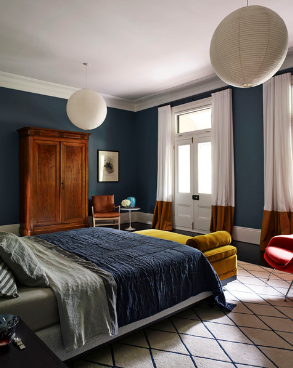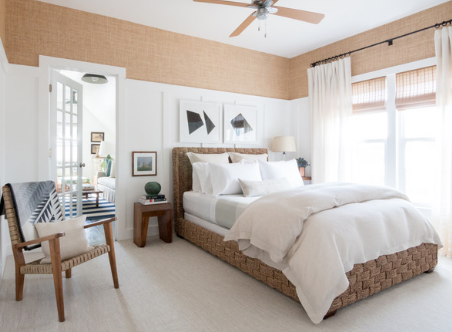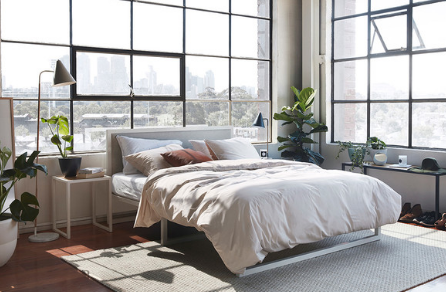

The main focus of many people who work with interior designers is the kitchen or bathroom. This is understandable considering the functional importance of these rooms and the cost of renovation. It’s a shame that bedrooms are often overlooked and don’t receive the same level of attention.
From an interior designer’s point of view, the bedroom shouldn’t be an afterthought at the end of a long-term project. Even though the design work in a bedroom isn’t as dense as a bathroom or kitchen, your designer still needs to know quite a few details to make this important room work for you.

When considering a bedroom, designers will first focus on a few key areas: circulation, furniture placement, landscaping, outdoor access, light, and ventilation.
In the initial discussion, you’ll be well served if you share your wish list (what you want to do in the bedroom) and behaviors (what you do there, except for the obvious). Let’s unpack these two important factors and add some others.

Like any other room, you’ll need to make a wish list for your bedroom. It’s all about clarifying your needs and your desires. The list should also reflect elements of your existing behavior. This will help shape your project through the design process.
Wish lists can range from major initiatives such as adding new exterior doors to access private courtyards to smaller details such as wanting a bedside sconces or recesses for ceiling mounted curtains.
Take the time to collect photos that reflect your taste. For example, you can create a creative book on Houzz to share. It’s easier to show your preferences with pictures than with words. You can tell if you’re looking for a specific style, a specific product, or just a cute color.

Next, you need to set your priorities. This is often budget-related and, like any other part of a design project, needs to be defined and communicated to the designer as early as possible. How much of the wish list you get depends on whether you’re willing to make a trade-off between what you really want to have in your new bedroom and what you have to have. The key reason to establish and articulate priorities is for both of you to have the same vision for the end result.

The way people use their bedrooms can vary more than the rest of the house. Revealing your Xi lets your designer know how you want to use the room. You may also want your bedroom to create a new set of behaviors or Xi.
If you share a room with another person, will one of you wake up earlier than the other? Is the sleeping partner willing not to be disturbed? Do you need a dark room to sleep in, as any hint of light will keep you awake? Or do you prefer to be woken up by the early morning sun? Do you spend a lot of time reading in bed before falling asleep?
Make a note of your usual sleep patterns and how you hope to maintain or improve them in your new bedroom. For example, if you’re reading a book in bed, you’ll think more about a comfortable and soft headboard for you to lean on, a bedside table for books, and good lighting for reading tasks. If you prefer a dark room, blackout curtains are essential.
Since it’s the centerpiece of most bedrooms, the style, size, and location of the bed are very important. Given that you spend a lot of time using the product, quality is also crucial. If you don’t plan to keep your existing bed, then the bed is the main piece of furniture you need to specify.

What is your bed size? The size of the room determines the size of the bed. Do you need extra storage space in your bedroom? Then a lift-up storage bed or a bed frame with drawers would be ideal. Have a small bedroom? A bed with legs is usually the best choice – being able to see underneath the bed adds a sense of space to the room and is considered excellent Feng Shui as it allows Qi (good cosmic energy) to move more freely around the room.
What other activities do I need to do in the bedroom besides the bed? Are you wearing clothes and makeup here, too? If so, what kind of wardrobe and clothes storage do you prefer? How about a well-lit mirror or dresser? If you dream of having a separate locker room or walk-in closet, tell your designer.
Do you hang out in your bedroom during your breaks? A comfortable bedroom chair or window seat may be required. Is your bedroom also your reading room? Add built-in bookshelves to your collection. If you crave a quiet haven away from the rest of the house, build it with your designer.

Agreeing on the size of the bed is essential to determine the rest of the furniture layout in the room. What other furniture and fixtures (existing or new) would you like to have? These items include bedside tables, bedside lamps, dressers, vanities, lounge chairs, wardrobes, chandeliers, bedside benches, shelves, mirrors, artwork, and rugs.

To conclude the design process, we looked at the mood and style of the bedroom. View the photos you’ve collected as part of your wish list. You’ll often find that there’s a common theme. Is it light, simple, and serene? Or is it dark, cozy, and richly textured?
Also consider the style of the house – is it traditional, modern, rustic, or eclectic? Keep in mind that the bed is a big item, so the sheets you choose will be the main feature. Good design takes time and will evolve as you work through the process with a designer. But the results are often better than you expected, helping you get a good night’s sleep and have sweet dreams.